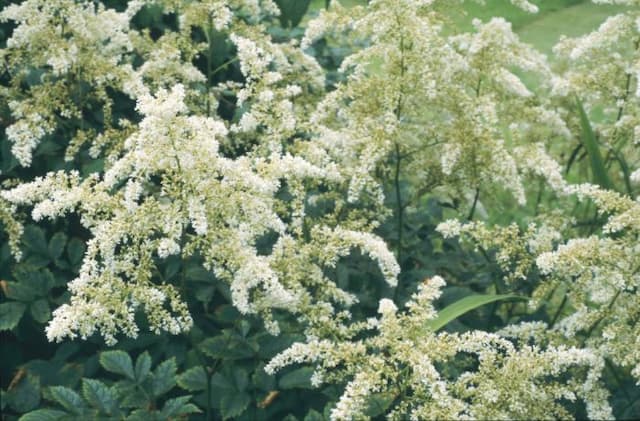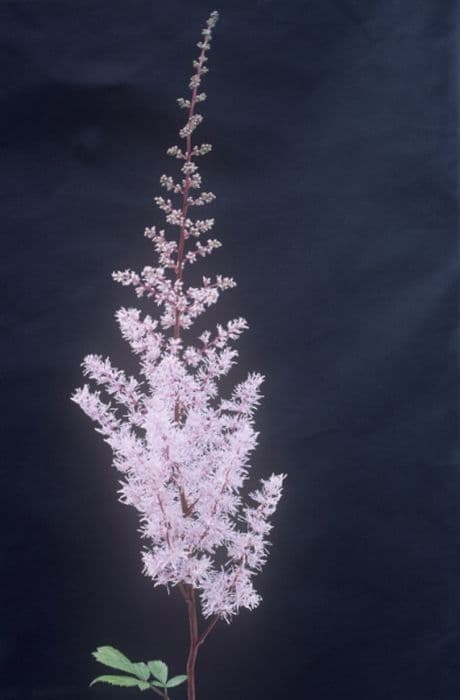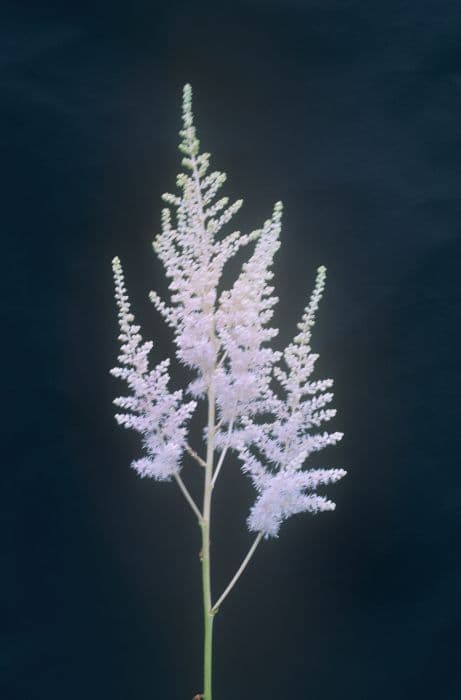Foam flower 'Spring Symphony' Tiarella 'Spring Symphony' (PBR)

ABOUT
'Spring Symphony' is a clump-forming herbaceous perennial, to about 30cm, with deeply-lobed, green leaves marked with dark purple along the midribs. Upright stems carry spires of small, starry, creamy-white flowers, opening from pale pink buds, in late spring and early summer
About this plant
 Names
NamesFamily
Saxifragaceae
Synonyms
Foamflower, False Miterwort
Common names
Tiarella 'Spring Symphony' (PBR).
 Characteristics
CharacteristicsLife cycle
Perennials
Foliage type
Semi-deciduous
Color of leaves
Green
Flower color
Pink
Height
1 foot (30 centimeters)
Spread
2 feet (60 centimeters)
Plant type
Herb
Hardiness zones
4
Native area
North America
Benefits
 General Benefits
General Benefits- Attractive Foliage: The Tiarella 'Spring Symphony' has heart-shaped leaves with striking patterns that add visual interest to any garden.
- Showy Flowers: It produces beautiful, delicate pink and white flower spikes that can enhance the beauty of any landscape.
- Seasonal Interest: This foamflower variety offers multi-season appeal, with foliage color changes in the fall and blooms in the spring.
- Shade Tolerant: Tiarella 'Spring Symphony' is well-suited for shaded areas where many other plants struggle to thrive.
- Low Maintenance: It requires minimal care once established, making it a good choice for gardeners of all skill levels.
- Ground Cover: It spreads gradually, forming a dense mat that can help suppress weeds and stabilize the soil.
- Pollinator Friendly: The flowers attract bees and butterflies, promoting biodiversity in the garden.
- Disease and Pest Resistant: This plant is generally resistant to common garden pests and diseases, reducing the need for chemical treatments.
- Rabbit Resistant: While no plant is truly rabbit-proof, Tiarella 'Spring Symphony' is less appealing to rabbits than many other garden plants.
- Drought Tolerant: Once established, it can tolerate periods of drought, making it suitable for gardens with lower water availability.
 Medical Properties
Medical PropertiesThis plant is not used for medical purposes.
 Air-purifying Qualities
Air-purifying QualitiesThis plant is not specifically known for air purifying qualities.
 Other Uses
Other Uses- Photography Accents: The delicate flowers of the Tiarella can be used to enhance macro photography, providing a beautiful and intricate subject or backdrop.
- Fauna Attraction: Tiarella 'Spring Symphony' can be used in gardens to attract butterflies and other pollinators, supporting biodiversity in the garden ecosystem.
- Educational Model: Due to its unique foliage and flowering habits, this plant can serve as an educational specimen for botany students studying plant morphology and reproduction.
- Culinary Garnish: The flowers, though not widely recognized for culinary use, can potentially be used as a decorative, edible garnish on special dishes in high-end culinary presentations.
- Artistic Inspiration: Artists can draw inspiration from the intricate leaves and flower spikes of Tiarella 'Spring Symphony' to create botanical illustrations, patterns, and designs.
- Theme Gardens: This plant can be featured in fairy or gnome themed gardens due to its whimsical appearance, complementing a playful, fantasy aesthetic.
- Landscape Photography: Tiarella 'Spring Symphony' can be strategically planted and employed as a striking foreground interest in landscape photographic compositions.
- Crafting: Dried Tiarella flowers can be integrated into craft projects, such as handmade cards or pressed flower arrangements.
- Soil Erosion Control: The dense clumps formed by Tiarella 'Spring Symphony' can be used on slopes and banks to help stabilize soil and prevent erosion.
- Mood Enhancer: Having 'Spring Symphony' in a home or office environment can lift spirits with its lively blooms, adding a touch of cheerfulness to the setting.
Interesting Facts
 Feng Shui
Feng ShuiThe Foamflower is not used in Feng Shui practice.
 Zodiac Sign Compitability
Zodiac Sign CompitabilityThe Foamflower is not used in astrology practice.
 Plant Symbolism
Plant Symbolism- Innocence: The delicate white flowers of the Foamflower, a common name for Tiarella 'Spring Symphony', symbolize purity and innocence, often used to convey a sense of simplicity and unspoiled beauty.
- New Beginnings: The Foamflower often blooms in the spring, making it a symbol of rebirth and new beginnings as it is one of the first plants to herald the end of winter.
- Protection: The dense foliage and mat-forming habit of Foamflower can symbolize protection, as it covers the ground like a protective blanket.
- Nativeness: The Foamflower is native to North America, which can symbolize a respect for local flora and the value of natural heritage in gardening practices.
 Water
WaterThe foamflower, or Tiarella 'Spring Symphony', prefers consistently moist soil but not waterlogged conditions. Water the plant when the top inch of soil feels dry to the touch, which typically means watering about once a week. Depending on the size of the plant and the environmental conditions, you might need to water with about 1 gallon of water per week for a medium-sized plant. During hot and dry periods, the frequency of watering should be increased to maintain moisture, whilst during the winter or in cooler climates, reduce the watering slightly. It's best to water directly at the soil level to avoid wetting the foliage, which can lead to fungal diseases.
 Light
LightFoamflowers do best in partial to full shade environments, thriving under the dappled light of large trees or on the north side of buildings where they can be protected from the intense afternoon sun. A spot that receives morning light but is shaded during the hottest part of the day is ideal for Tiarella 'Spring Symphony'.
 Temperature
TemperatureFoamflowers are resilient to a range of temperatures and can survive in conditions as low as 20 degrees Fahrenheit, but they thrive best in a temperature range of 60 to 75 degrees Fahrenheit. They should be protected from extreme heat and frost, which may damage the plant.
 Pruning
PruningTiarella 'Spring Symphony' or foamflowers should be pruned to remove spent flower spikes and encourage a second bloom. Deadheading after the first blooms have faded can help maintain a tidy appearance and promote additional flowering. Pruning in late winter or early spring is also beneficial to remove any damaged or dead foliage and to shape the plant.
 Cleaning
CleaningAs needed
 Soil
SoilFoamflower 'Spring Symphony' prefers a soil mix with good drainage and high organic content. A blend of two parts peat moss, one part loam, and one part perlite or sand is ideal, creating a rich yet well-draining substrate. The soil pH should be slightly acidic, between 5.5 and 6.5, to facilitate optimal growth.
 Repotting
RepottingFoamflower 'Spring Symphony' generally does not need frequent repotting and can thrive in the same pot for several years. Repotting is typically only required if the plant has outgrown its current container or if the soil needs refreshing. This might be every 2-3 years, during the spring.
 Humidity & Misting
Humidity & MistingFoamflower 'Spring Symphony' thrives best in moderate to high humidity levels, around 50-70%. They do well in environments that mimic their natural woodland habitat, which can often be achieved in a typical home setting without additional humidity measures.
 Suitable locations
Suitable locationsIndoor
Place Foamflower in bright, indirect light and ensure high humidity.
Outdoor
Plant in partial shade, moist soil, and protect from afternoon sun.
Hardiness zone
4-9 USDA
 Life cycle
Life cycleFoamy Bells 'Spring Symphony' (Tiarella 'Spring Symphony' (PBR)) begins its life cycle as a seed, which under appropriate conditions of moisture and temperature, will germinate and sprout into a seedling. The plant will then enter a vegetative stage, where it produces foliage and robust root systems, developing characteristic heart-shaped leaves and forming a low-growing clump. As it matures, Foamy Bells 'Spring Symphony' produces striking flower spikes with small, fluffy, star-shaped white or pink blooms in the spring. After pollination, often by insects, it may set seeds that can be dispersed to produce new plants. During the growing season, this perennial will experience periods of growth and dormancy, with foliage sometimes dying back in the winter depending on the climate. Over several seasons, the clump may expand by vegetative propagation through stolons or division, gradually increasing in size and potentially requiring division to manage its spread.
 Propogation
PropogationPropogation time
Early spring
The Tiarella 'Spring Symphony', commonly known as Foamflower, is typically propagated by division in the fall or spring. Division is the most popular method as it is straightforward and effective for this perennial plant. To propagate by division, carefully dig up the Foamflower plant, ensuring to include as much of the root system as possible. The clump should then be gently separated into smaller sections, each with a portion of the roots and some shoots. Replant these divisions immediately, spacing them about 15 to 18 inches (approximately 38 to 46 centimeters) apart, and water them well to encourage establishment in their new location. This method allows for rapid increase of the plant and maintenance of its desirable characteristics.









